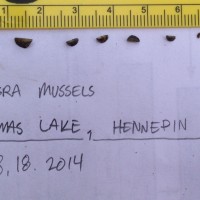<div class=”d4p-bbt-quote-title”>PikeFishman wrote:</div>
For those of you who are skeptics of the way the DNR handles invasives, how do you propose we limit the spread? I know I want my son and his future kids to be able to enjoy lakes without worrying about slicing their feet open on a zebra mussel on the beach…
I am no criticizing, but instead looking for solutions and not just criticism.
PS – I am not involved with or do I have any relationship with any members of the DNR.
How do we limit the spread? Find a way to kill them seems like a better solution to me than limiting the use of public waters. The way its going Ill be telling my grand kids stories about the good old days of getting up early in the morning and going to fish any water I wanted. Pre scheduled boat checks, road side stops, decontamination stations, boat landing inspections, closed down water ways, limited hours to landings. These are all great ways to stop fishermen. Not so good for stopping invasive.
Mike, I totally agree we should be looking for ways to limit the spread.
Education and Stiffer Fines for transportation of “Invasives” would seem to be the best methods. Many I have listen to in other forums and hearings have suggested a Quarantine of Watercraft along with Docks & Lifts from Infested Lakes. As from recent reports from the Inspectors at Lake Accesses where they have actually stopped incoming watercraft with Violations, namely just Zebra Mussels attached are ALL from Watercraft that are homed based/moored &/or docked in the locally infested lakes (namely Lake Minnetonka & Prior Lake).
That said as Zebra Mussels from their “Veliger Stage” once attached to an object Do Not & Cannot move or jump onto another object. They are permanently attached to that object for life. That said, however also means that with object such as Docks, Lifts & Watercraft that have been sitting in the infested lakes can and many do have Zebra Mussels attached, thus they can be transported to other lakes by man. It does take the object to be sitting in the infested lake for a period of time to allow the “Veliger” to attach and begin growing. With that said & that knowledge, the only true problem with boats incoming and outgoing from lake to lake is any water from the infested lake being transported from lake to lake. Thus as most fishing boats go, if you “Clean, Drain & Dry” you should be good to go when you enter the lake in the morning and leave again the same day.
If a boat on an infested lake is sitting on a lift, clearly out of the water including the motor/lower unit, then too, they should be good to go. On the other hand, if your boat is sitting in the water for more than a say a 24 hours or more hours tied to a dock or mooring, then your watercraft is suspect to having Veliger’s attach and begin their growth into a Zebra Mussel. This also goes for transportation of weeds, which in Minnesota, I have heard of Zebra Mussels attaching to weeds, especially Eurasian Water Milfoil on lake Minnetonka. Thus, you could have a piece of weed, with a number of small “Veliger’s or Zebra Mussels” attached to your water craft &/or trailer.
Getting to summarizing this, if you are transporting docks, lifts, watercraft and/or weeds from an infested lake, you could and should be stopped & tagged.
Ok, I think I’ve made my point. Were wasting out time & money inspecting every boat coming and going from many public accesses. We need to focus on the Lakeshore Owners Watercraft, Docks and Lifts coming out of infested lakes.
As far as Inspector’s at other accesses, they are more of an Inspector/Educator to see that we watercraft operators are not transporting Water & Weeds, which may be Invasive to another body of water and to teach to “Clean, Drain & Dry”.
